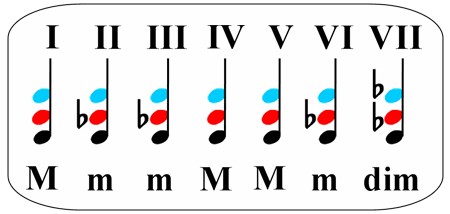I’ve learned over the years from former piano students that there are certain words pertaining to music theory that conjure up negative feelings. I think this is because they’re perceived as sort of lofty and difficult to understand. Diatonic is definitely one of those words. I have to admit that it’s not commonly used in everyday language. This article is about how diatonic harmony works on the piano.
conjure up negative feelings. I think this is because they’re perceived as sort of lofty and difficult to understand. Diatonic is definitely one of those words. I have to admit that it’s not commonly used in everyday language. This article is about how diatonic harmony works on the piano.
It’s not hard to define. Diatonic simply means “in the key of.” The word itself is a derivative of “dia” as in diagonal (meaning across) and tonic (as in the tonic or tonal center of a key). So if a chord or a series of notes belongs to a particular key, then it’s ![]() referred to as diatonic Most chords that are in a song are diatonic. Think of them as being members of the same family. So now that we’ve seen how simple it is to define the word diatonic, let’s see how easy it is to discover how diatonic harmony works on the piano.
referred to as diatonic Most chords that are in a song are diatonic. Think of them as being members of the same family. So now that we’ve seen how simple it is to define the word diatonic, let’s see how easy it is to discover how diatonic harmony works on the piano.
The best example to illustrate how diatonic harmony works on the piano is to utilize the key of C Major. The reason for this is one of visual simplicity. The key of C Major on the piano consists of all white keys. This means that we don’t have the complexity of a combination of black and white keys to confuse us. You’ll see what I’m talking about in a moment.
Here we have the key of C Major. It can also be referred to as the diatonic scale of C Major.

You’ll notice that there aren’t any black keys in the key of C Major. All notes are diatonic to the key of C Major. This is the simplest way to illustrate the diatonic concept.
No other Major key of music has all of these exact diatonic tones. Now if you’re familiar with other Major keys of music, you may be aware that they also share some of the same diatonic tones as C Major. Some, but not all. For example, the key of F Major also shares the note C. C is also a diatonic note of F Major. But the biggest difference is the numbered sequence of these tones.
C is the tonic of the key of C Major. Like I said before the tonic is the tonal center or you can simply say it’s the first note of the key. In the key of F Major, C is the 5th note in the key.

C is also the 4th tone in the key of G Major.

So it’s easy to see the same diatonic note or tone as I’ve also referred to it, will appear in several different keys of music. But it’s important to know that the numbered sequence of the notes are absolutely essential to understanding diatonic harmony. You may have the same note in more than one key, but its number sequence will be different in each of them. Here’s the numbered sequence of the diatonic key of C Major:

Each one of these diatonic tones has a corresponding chord with the same numbers.
1 Chord C Major

2 Chord D minor

3 Chord E minor

4 Chord F Major

5 Chord G Major

6 Chord A minor

7 Chord B diminished

As you can see, these diatonic chords are combinations of Major and minor chords with one diminished chord. If you’re not familiar with diminished chords, just think of them as a type of minor chord with the 5th lowered a half step.
These 7 different chords are a pattern that exists in every Major Key of Music.

You should also know that diatonic harmony can also go beyond just basic triads (three note chords). You can extend these diatonic chords and they’ll still exist within the framework of the diatonic patterns that I mentioned earlier. The following C Major 7th chord is nothing more than a C Major triad with an added 7th tone.

I won’t go into extended diatonic chords any further in this article, but they could also include extended tones such as 9ths, 11ths and 13ths and those extended tones would still be the ones that exist within the key.
Just like individual notes, chords are also diatonic across more than one key. For example, C Major 7 is the 1 chord in the key of C but it’s also the 4 chord in the key of G Major.
Because of this difference in the number sequence, their function is different within a song or piece of music. If I were playing a 1-4 chord progression in the key of C Major, I would be playing a C chord to an F Chord. That same progression in the key of G Major would be a G chord to a C chord. Another way to look at this number sequence is that any chord that you play is relative to the key that it’s in.
So what is the best way to determine what the diatonic harmony is in any key? You should first know the 7 different notes in any given key. Beyond that, you should also know that diatonic harmony is tertian. That’s to say that it’s built on intervals of thirds. Intervals are just the distances between two notes.
The simplest way to find these third intervals, is to locate every other note that’s in the key of music you’re working in. It’s very simple to do when you’re working in the key of C Major because all you have to do is skip every other white key.

This strategy of skipping every other note works in any Major key. It is however slightly more challenging in other keys of music because you have a combination of white and black keys. That’s why it’s important to know your keys of music very well.
Knowing the diatonic harmony of every key of music will serve you well and make it much easier to learn chords as well as voicings for any popular style of music. So learn diatonic harmony and have fun doing it.
Until next time, Go Play!
Greg Lee
Latest posts by Greg Lee (see all)
- What is a minor/Major 7 Chord? - October 26, 2023
- 7 Chord Substitutions that Professionals Use - October 19, 2023
- 5 Simple Chord Tricks to Sound Amazing - October 5, 2023



